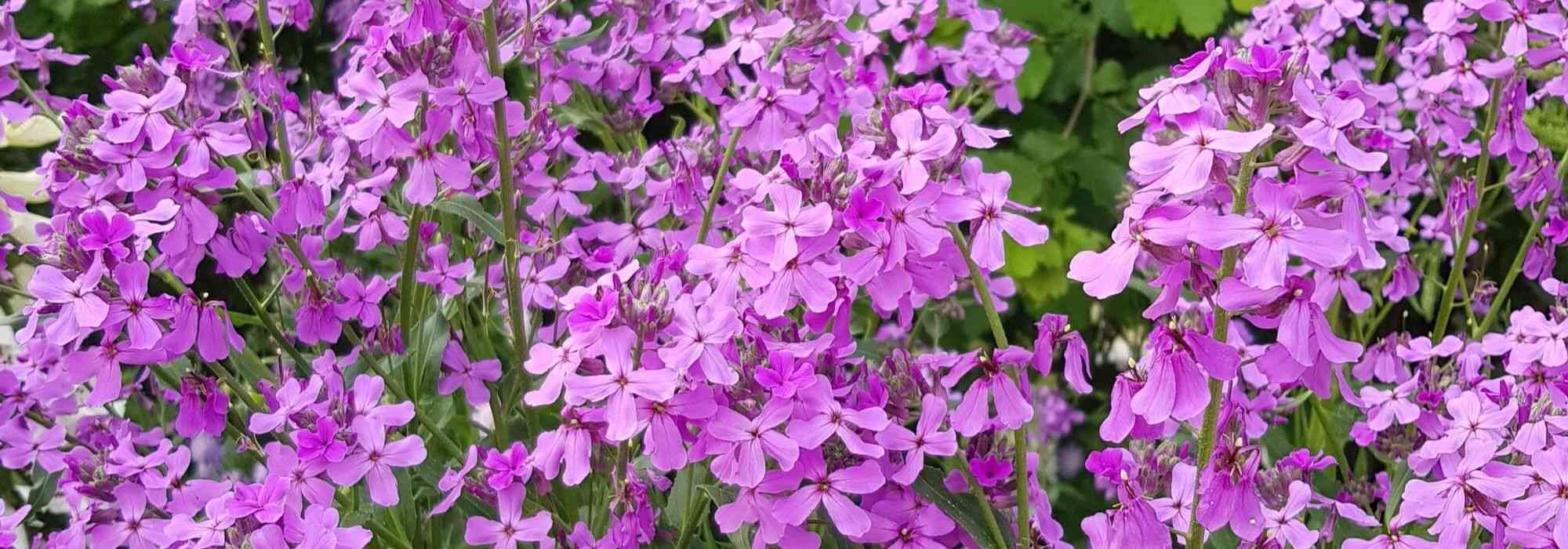
Dame's violet, Hesperis: planting, sowing, care
Contents
Dame's violet in a nutshell
- Hesperis matronalis, known as dame’s rocket, is one of the oldest flowers in our gardens
- Its mauve, lilac or white flowers diffuse a delicate jasmine scent, especially in the evening
- From May to July it produces large, upright, impressive inflorescences
- It grows in any good garden soil where it will self-seed freely
- Very common in cottage gardens, it is indispensable in a country garden, in wild gardens, in beds, rockeries and borders
A word from our expert
With its old-fashioned charm, Hesperis or Dame’s Rocket is one of those familiar flowers of our grandmothers’ gardens and of our country gardens where it self-seeds freely. Mainly grown is Hesperis matronalis, a short-lived perennial that can reach up to 1.50 m tall. It is valued for its graceful, airy flowering and lilac flowers. It is available in varieties with white flowering, single or double, such as Hesperis matronalis ‘Alba’ and Hesperis matronalis ‘Flore Pleno’. Their main asset is a powerful jasmine scent that intensifies at dusk, which explains why the plant was given the name Hesperis, meaning the evening hour in Greek mythology.
With the charm of wild plants, Hesperis flowers all summer in any good garden soil. Dame’s Rocket leaves are also edible and will enhance both bouquets and summer salads!
This lovely hardy perennial is among the champions of abundant flowering, fits easily into wild and country gardens and lends itself to many planting combinations.
Absolutely delightful, discover Dame’s Rocket, this accommodating flower accessible to all gardeners!
Description and botany
Botanical data
- Latin name Hesperis
- Family Brassicaceae
- Common name Dame's rocket, Common dame's rocket, Sweet rocket, Silver rod, Cassolette, Dame's violet
- Flowering April to July
- Height 0.45 to 1.50 m
- Exposure sun, partial shade
- Soil type all, well-drained
- Hardiness -15°C and beyond
Native to Europe, Siberia and Asia, Hesperis or Dame’s rocket, also called “Common dame’s rocket”, “Garden dame’s rocket”, “Sweet rocket” or “Girarde” by another nickname, is a short-lived perennial belonging to family Brassicaceae, like oilseed rape or mustard. In the wild it grows in meadows, fallow or woods but is also found in some mountainous areas such as the Alps where it has naturalized. Although Dame’s rocket is theoretically perennial, it often behaves as a biennial.
The genus comprises about sixty species — annual, biennial or perennial — among which Hesperis matronalis, with its abundant lilac-pink flowering, is the only one commonly found in gardens, although it occurs in cultivars with single or double flowers in red, pink or white such as H. matronalis ‘Alba’. There is also H. matronalis var. Albiflora, a botanical variety. Also known as Sisymbrium luteum, Hesperis lutea is a species with pale yellow flowers.
With very rapid growth, the plant forms an herbaceous, upright tussock with a rosette habit, reaching 60 cm up to 1.20 m in height. It is a short-lived perennial that rarely lives more than three years but self-seeds abundantly.
Tall, well-ramified and pubescent stems bear deciduous foliage. Leaves are large, smooth, 10 to 25 cm long, lance-shaped, sessile, with dentate margins, arranged alternately along the shoots. Shiny and more numerous at the base, they range from dark green to deep green. Some varieties such as ‘Variegata’ are distinguished by strongly variegated green and yellow foliage. Young leaves are edible and have a slightly bitter flavour that can season salads.

Hesperis matronalis – botanical illustration
The flowering, particularly graceful, opens at stem tips from April to July depending on climate. Flowers, made up of four cross-shaped petals 2 to 4 cm across, are grouped in terminal clusters or panicles. These inflorescences are at once delicate and striking. Most often single, some cultivars bear semi-double or fully double flowers, often more fragrant than single-flowered types. Flowers release a set of six stamens.
Flowers of Hesperis matronalis are lilac-pink, but there are also white forms and, in Hesperis lutea, red or yellow forms.
They make excellent cut flowers, lovely in soft, romantic bouquets.
Very fragrant in the evening, these small flowers exude an intense, delightful jasmine scent. The name Hesperis, from Greek meaning “evening”, alludes to the perfume of its flowers becoming stronger at day’s end.
This melliferous and fragrant flowering attracts many insects, bees and butterflies, which ensure its pollination.
Fruits of Dame’s rocket are small, dehiscent and erect siliqua capable of easily self-seeding in the garden — a boon for this short-lived perennial.
Very hardy to -15°C to -20°C and beyond, Hesperis matronalis establishes across all regions. It is undemanding and will thrive in any good, well-drained garden soil. Plant in sun or partial shade in warm areas. Well suited to wild gardens and a familiar sight in cottage gardens, it self-seeds profusely and adds a slightly untamed charm.
Read also
Care of perennial plantsMain species and varieties
Most popular
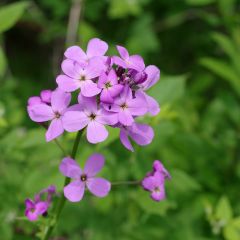
Hesperis matronalis
- Flowering time June to August
- Height at maturity 90 cm
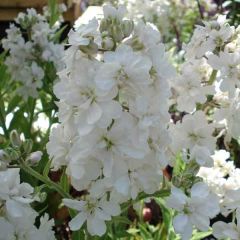
Hesperis matronalis Flore Pleno
- Flowering time June to August
- Height at maturity 70 cm
Our favourites
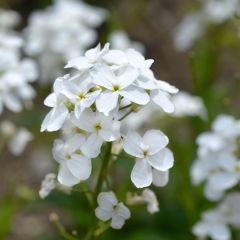
Hesperis matronalis Alba
- Flowering time June to August
- Height at maturity 70 cm
Discover other Hesperis
View all →Available in 0 sizes
Available in 1 sizes
Available in 0 sizes
Available in 2 sizes
Available in 1 sizes
Available in 1 sizes
Available in 1 sizes
Available in 1 sizes
Planting
Where to plant dame’s rocket?
Very hardy (below -15°C), Hesperis acclimatises across France. As flowering thins over the years, it is often grown as a biennial.
It is a plant that grows equally well in non-scorching sun or light partial shade in the warmest regions. It tolerates any good garden soil but will flower more profusely in deep, rich, fresh, well-drained soil. It prefers soil that does not dry out too deeply and that stays cool in summer. Its roots will not tolerate excess water in winter, which can cause them to rot.
With its bushy habit, Hesperis suits cottage gardens, wild and naturalistic gardens, wildflower meadows, and to colour flower beds and borders.
When to plant dame’s rocket?
Plant Hesperis in spring (March–May) or autumn (September–November). Most important is to avoid frosty periods or very hot weather.
How to plant dame’s rocket?
In open ground
Plant Hesperis in groups of 6–8 plants per 1 m², spacing 30–45 cm and without burying the collar.
- Dig over soil thoroughly
- Dig a hole 2–3 times wider than the rootball
- Spread a layer of gravel at the bottom of the hole for drainage
- Place rootball in centre of hole, collar 2 cm below soil surface
- Backfill and firm down
- Water generously
In a pot
Dame’s rocket can also be easily grown in a pot; plant in groups of 3–4 plants in a container about 60 cm in diameter.
- Spread gravel or clay pebbles at bottom of pot
- Plant rootball in a draining mix made of 70% potting compost and 1/3 garden soil
- Water after planting
More tips to plant perennials successfully on our blog!
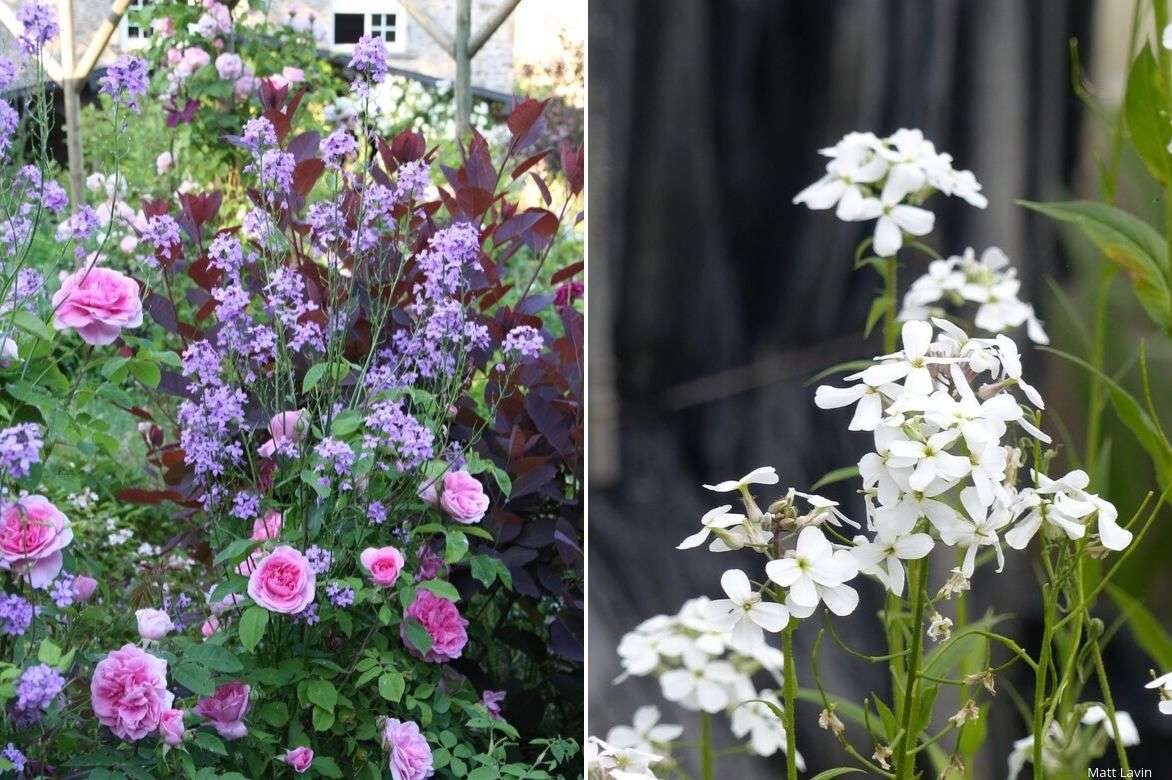
Dame’s rocket with the rose ‘Gertrude Jekyll’ and purple foliage of Cotinus ‘Grace’ / Dame’s rocket is also available in white form (Hesperis matronalis ‘Alba’) !
Read also
Succeeding in sowing perennial plantsCare
Hesperis does very well and flowers for a long time without much attention.
It prefers fresh but not waterlogged soil. Water especially during hot, dry spells to support flowering. In a pot, water more regularly as soon as soil is dry at the surface.
Fork in a little compost around base of plant in autumn and spring.
Cut off faded stems to encourage new flowers and prolong flowering, but this prevents the plant from self-seeding.
After flowering, let it set seed in place so that it self-seeds. It is a short-lived perennial whose flowering diminishes over the years, don’t hesitate to let it self-seed. Cut back clumps after flowering if you wish to avoid these spontaneous sowings.
Slugs, which covet its young foliage, are its only enemies: follow our advice to combat gastropod attacks.
Propagation
Dame’s rocket self-seeds in garden, but you can also do sowing to maintain this ephemeral perennial in garden. So don’t hesitate to collect seeds as soon as they are ripe and store them in paper bags.

Seeds of Hesperis matronalis
Sowing
You can sow the Dame’s rocket seeds from April to July, as soon as temperatures reach 18-20°C. You can also sow under cover in autumn. It behaves like a biennial, flowers appearing only in year following sowing.
Discover our tips and tricks to succeed in sowing perennial plants on our blog!
Under cover
- Prepare a seed tray filled with seed compost
- Sow seeds on surface
- Cover with thin layer of substrate and keep moist until germination
- Water with a fine spray
- When young plants reach two-leaf stage, pot into buckets
- Plant out young plants in the garden once risk of frost has passed and when outside temperature is above 18°C
- Space young plants about 50 cm apart
- Water to ensure establishment
In open ground
It is also possible to carry out direct sowing in open ground as soon as temperatures have warmed to 18°C.
- Sow in drills
- Keep soil moist until germination
- After emergence, thin out leaving about one plant every 50 cm
Companion planting with dame's rocket in the garden
Hesperis, or dame’s rocket, has a handsome bushy habit and a bright, scented flowering, lilac, white or pink depending on variety, that fits easily into natural gardens and wild ones, country gardens, a cottage garden and scented gardens, to which it brings lightness. We recommend favouring pastel shades; together they create a calming, harmonious and gentle atmosphere.
In a mixed border close to the house to enjoy its delicious jasmine scent, it will pair easily with perennial wallflowers, indigo lupins, Caucasian forget‑me‑nots, bergenias or garden valerian. Also pair its delicate flowering with campanulas!
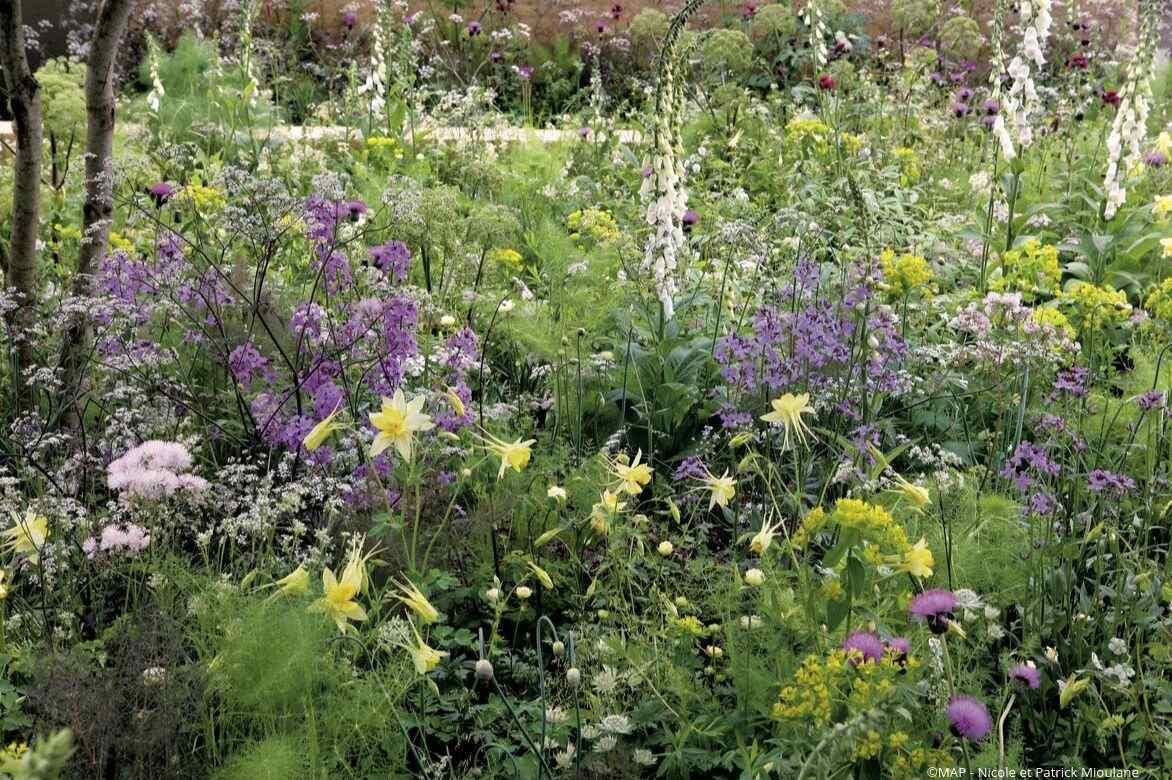
A fine example of a natural pairing: Hesperis matronalis, Thalictrum aquilegiifolium, Fennel ‘Bronze’, Aquilegia chrysantha ‘Yellow Queen’, Digitalis purpurea ‘Alba’, Euphorbia ( Euphorbia wallichii for example), Anthriscus sylvestris ‘Ravenswing’, Angelica sylvestris, Astrantia major ‘Shaggy’, Cirsium rivulare ‘Trevor’s Blue Wonder’
In a spring border, pair it with daffodils and tulips.
In an exuberant planting, its spikes laden with flowers will emerge gracefully among bushy perennials such as hardy geraniums, prized for their long flowering, often mauve, pink or white, agastaches, toadflaxes, plants equally easy to grow.
At the heart of a beautiful white garden, the elegant white‑flowering varieties will be perfect mixed with love‑in‑a‑mist, Epilobium angustifolium ‘Album’, veronicas or white monardas, Antirrhinum majus ‘Royal Bride’, summer daisies or even a Papaver orientale ‘Royal Wedding’.
For a soft‑coloured summer atmosphere, pair it with lavenders, asters, gauras, honesty, stachys and nepetas with light flowerings. Temper pink tones by combining with the silver foliage of wormwoods. Its generous, very natural flowering always adds a slightly wild touch to borders where it sits well with delphiniums, rudbeckias, alchemillas.
In a scented garden, surround it with snapdragons (antirrhinums), Dianthus plumarius and paniculate phlox.
→ Discover 9 great pairing ideas with Hesperis in our advice sheet
Useful resources
- Get ideas for pairing dame’s rocket : naturalistic garden
- Low-maintenance, in flower all summer, Hesperis makes its mark in a country garden
- Plant dame’s rocket in a colourful mixed-border where it attracts pollinators!
- Subscribe!
- Contents
.
Embrace the charm of Hesperis in your garden and enjoy its vibrant colours and delightful fragrance throughout the blooming season. Everything You Need to Know About the Dame's Rocket](https://en.promessedefleurs.eu/blogwp/wp-content/uploads/2019/09/hesperis-tout-savoir.jpg)































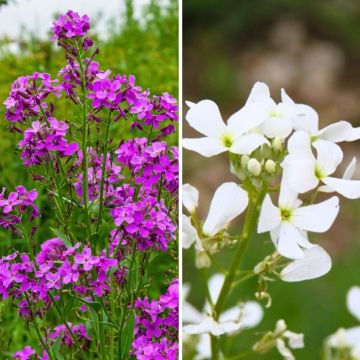

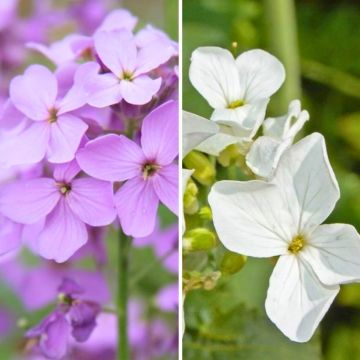

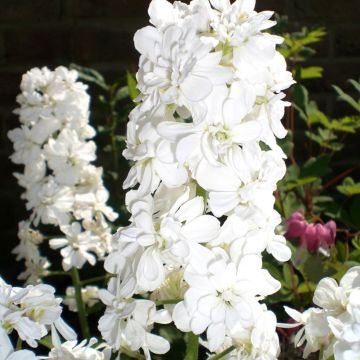
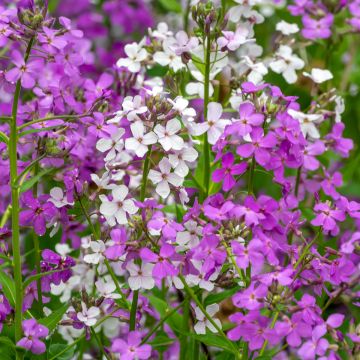

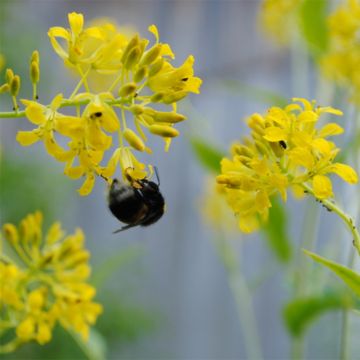
Comments